A visit to Auschwitz
A visit to Auschwitz is easy to plan. The camp is not very far from the airport of Katowice. A rental car is a must, but they are not really expensive in Poland. By car it's about 35 minutes drive to Oœwiêcim (the town where Auschwitz is located). Moreover, the trip can be combined with other places of interest like the city of Krakow. In Krakow are several WW2 places of interest, for example the former factory of Oskar Schindler which has been converted into a modern museum of the Second World War.
Auschwitz I
On arrival in Oœwiêcim you can choose to visit Auschwitz I or Auschwitz II (Birkenau) first. Auschwitz I is the smaller camp with the stone barracks. The former Polish army base was converted by the Germans into a concentration camp. The camp is best known for the famous Arbeit Macht Frei gate, which oddly enough is not the first view of the camp, after the passing of some buildings you'll arrive at the gate.
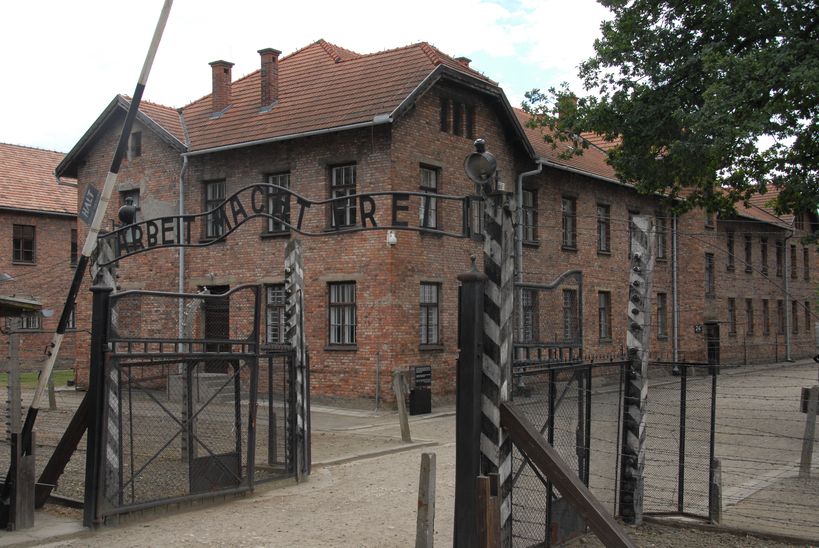
Several buildings are used as exhibition rooms. The first row of barracks are used for exhibits about the war in Poland and other general information about the war. The second row of barracks, including the infamous Block 11, mainly display information and materials about the two camps.
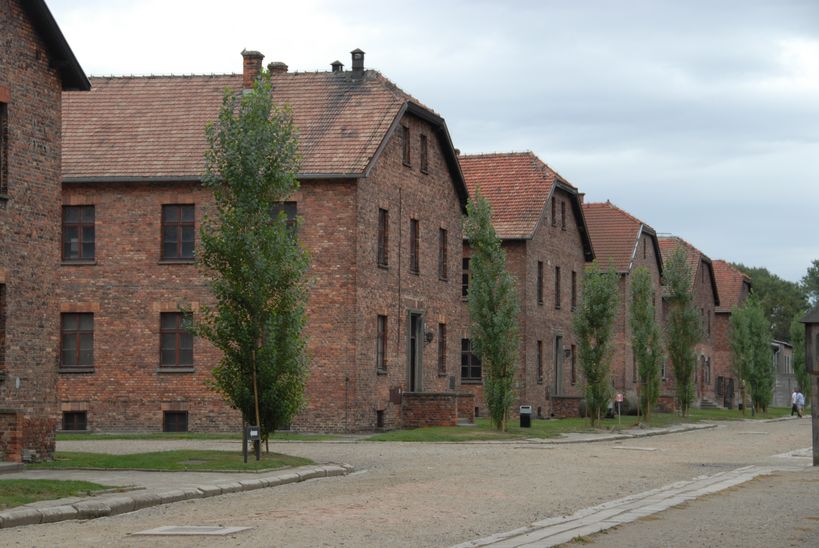
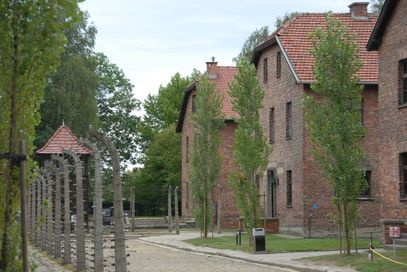
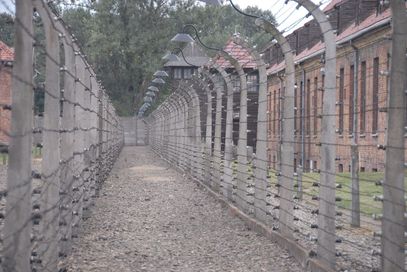
A very strange fact is that some barracks and the former home of Rudolf Höss are in use as houses. These houses overlook the gas chamber of the camp and the gallows where Rudolf Höss was hanged after the war. They are part of the camp but are separated by a steel gate.
Inside this gas chamber, thousands of people were killed. The gas chamber consists of several areas, including the gas chamber itself and a crematorium. In the crematorium is a turntable rails that is mounted on the ground. These were clearly to optimize and accelerate the killing process.

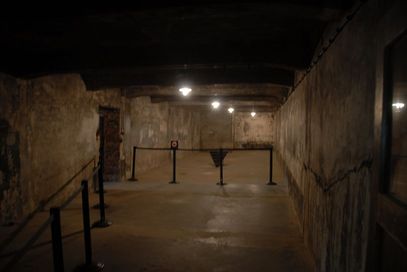
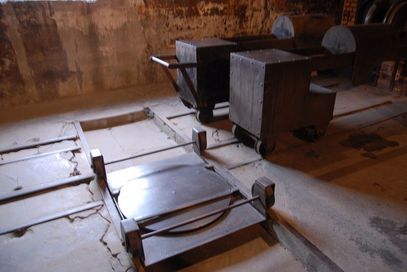
The most infamous building at the camp is undoubtedly Block 11 The building where the first gassings with Zyklon B took place. In the underground section where the gassings of Russian prisoners have occurred, are many cells that can be visited. Some of these cells are starve cells and standing cells .The atmosphere inside the barracks is sinister, the worn stairs to the basement was the last steps for many.
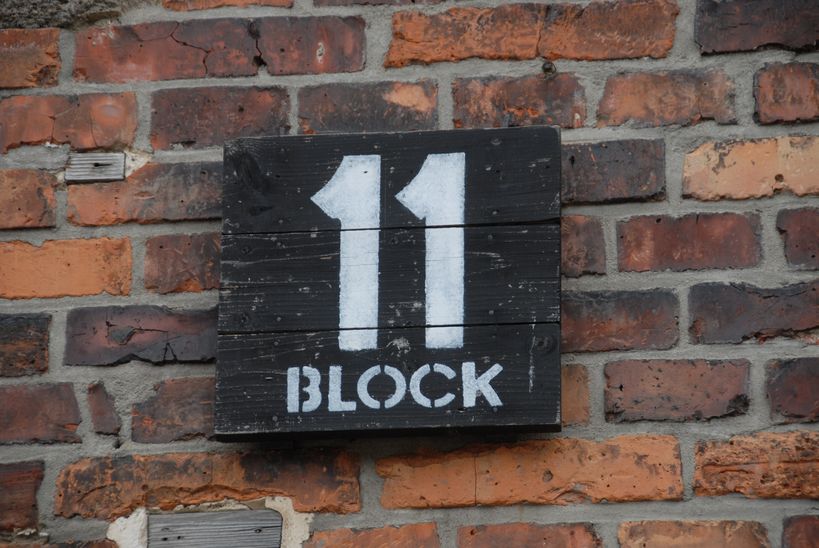
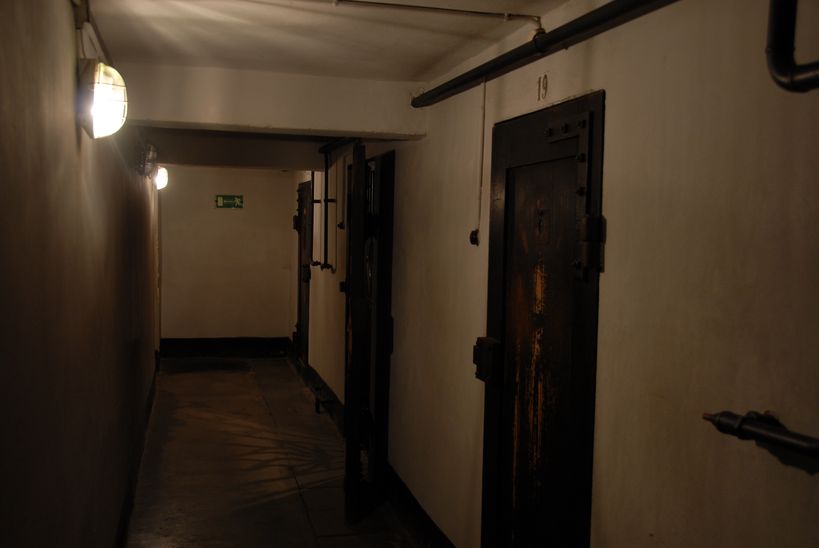
Next to Block 11, was an execution site.
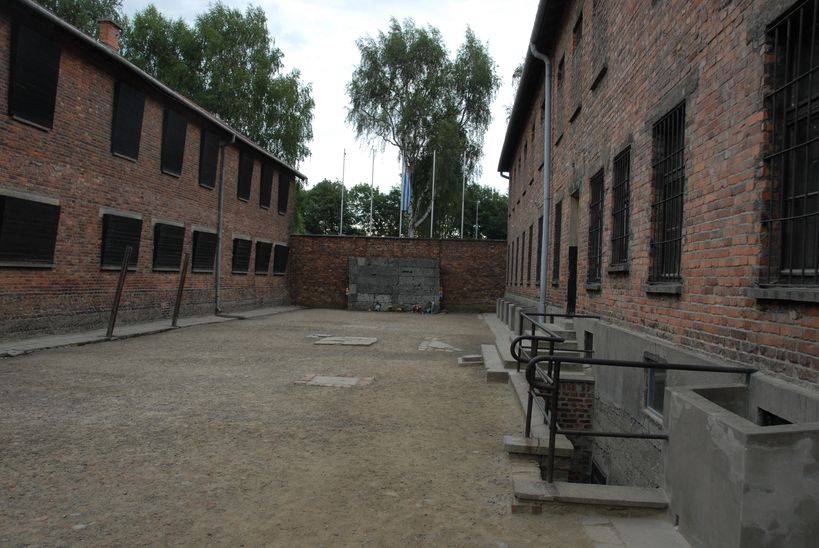
In the barracks next to Block 11, the camp life in Auschwitz is reviewed. The entrance hallways are filled with photos of prisoners who were murdered in Auschwitz.
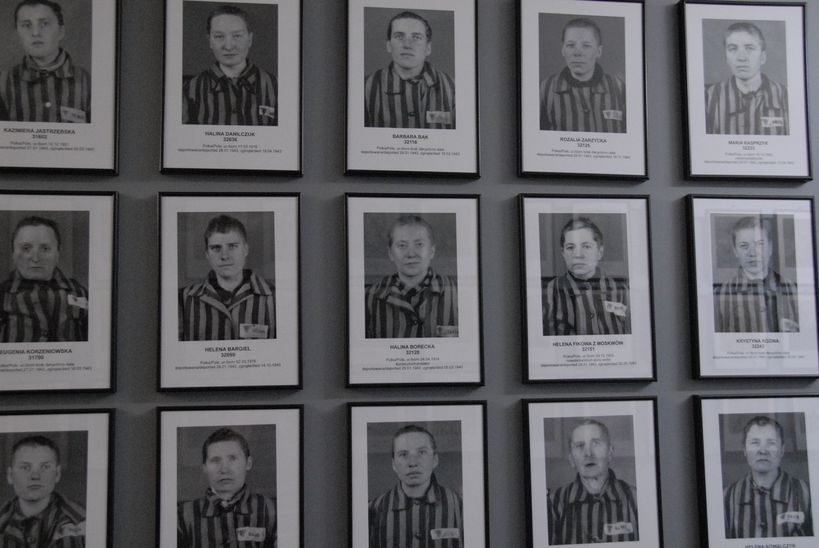
One barrack is filled with the properties of former prisoners. There are huge amounts of glasses, bags, shoes and many other items displayed.
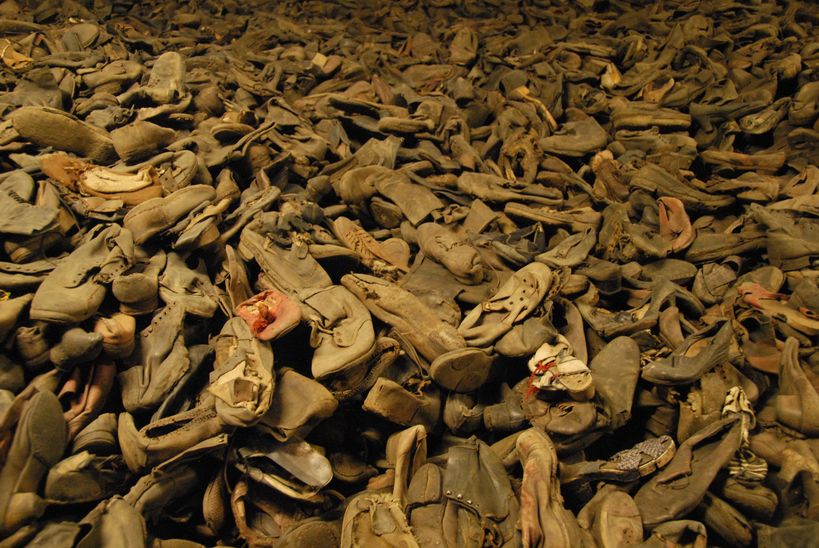
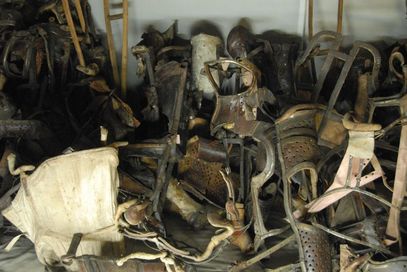
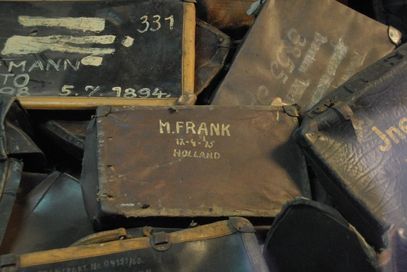
The gallows where the camp commandant Rudolf Höss was hanged stands about 100 yards behind his former home, right behind the gas chamber where many thousands were killed.
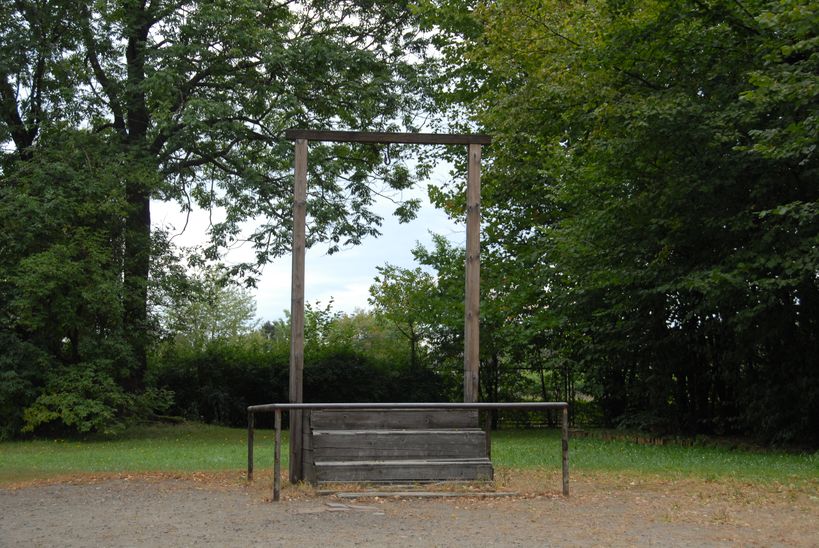
Auschwitz II
Auschwitz II (Birkenau) is a much larger camp which was built in a later stadium. This camp is clearly much more focused on murder than the first camp, had four gas chambers instead of one and the setup was much simpler and inhuman. On the road from Auschwitz I to II, it is worth to visit the Judenrampe. This former train platform was put into use as a memorial to the hundreds of thousands of people who arrived here after their long train journey. A cattle wagon, same type as was then used to transport the mostly Jewish victims, is a silent witness to what happened here.
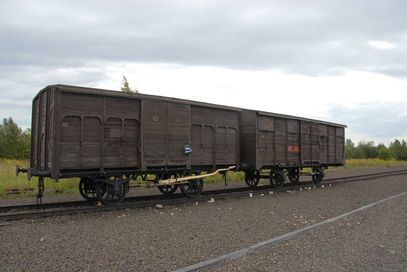
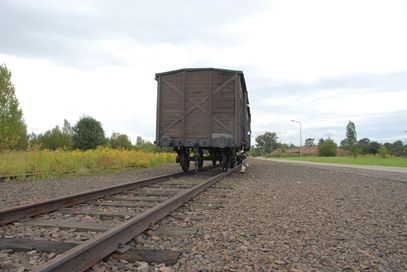
In short distance from the Judenrampe, you will find the spacious new parking lot for Auschwitz II. The well-known entrance of Birkenau, which in films appears to immense, is in practice a lot smaller. That’s not what you can say about the immense camp which lies behind this gate. The camp is so large that most people only walk along the platform up to the monument and former gas chambers II and III. Only a few walk along the entire camp, which has about a radius of 5 kilometers. The paths around the camp are not that good everywhere, diverse paths consist of large coarse pebbles which makes walking difficult. With a wheelchair it will be impossible.
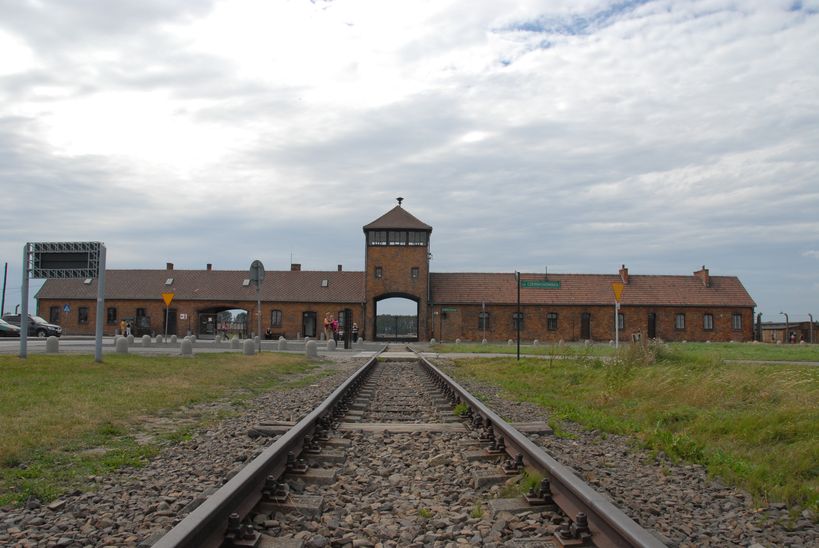
The route to the monument, which is also the route to the big gas chambers Krema II and Krema III is basically one big train platform. Halfway through the platform stands a cattle wagon and some boards with photographs showing how it looked like here in 1944. Many of the persons represented were killed shortly after arriving in one of the chambers that were in the camp. Of the gas chambers is not much left, they were blown up at the end of the war by the Germans, signs with photos and a layout make clear how they looked.
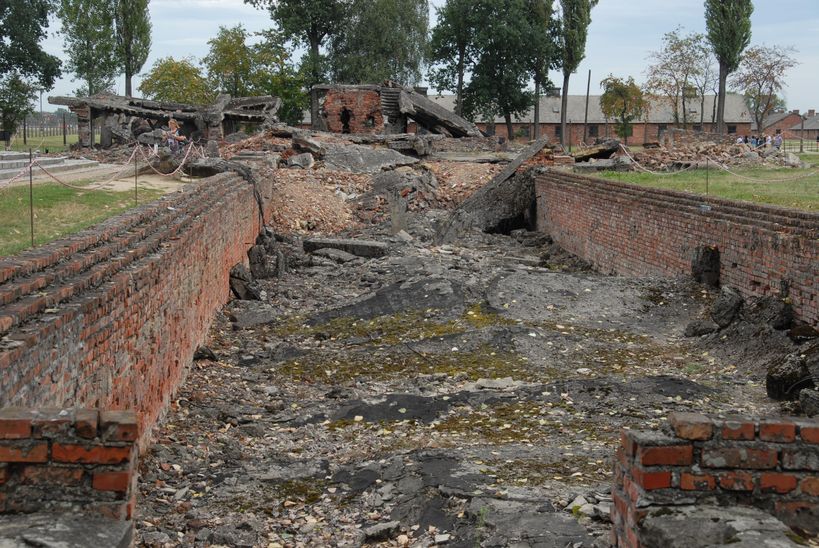
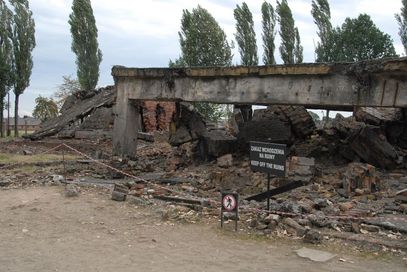
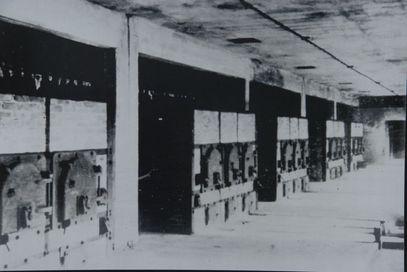
Krema II
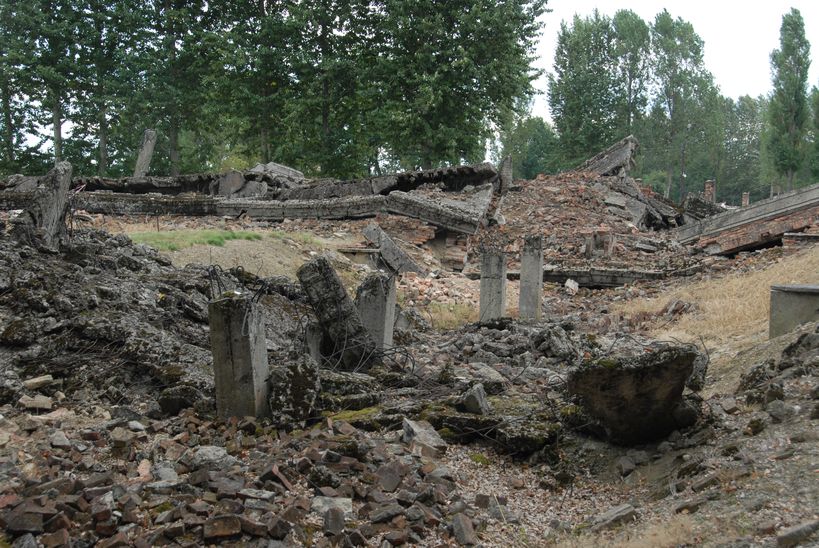
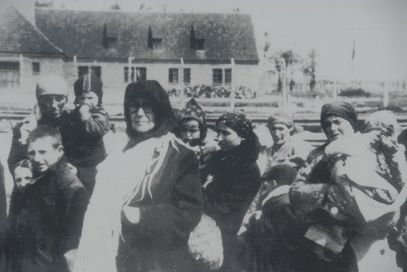
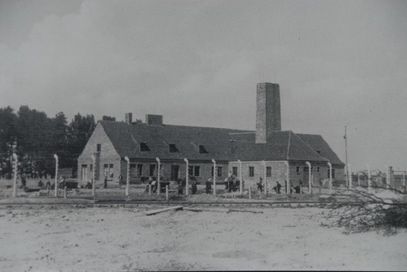
Krema III
To the right of these two chambers you can continue walking towards the gas chambers IV and V.
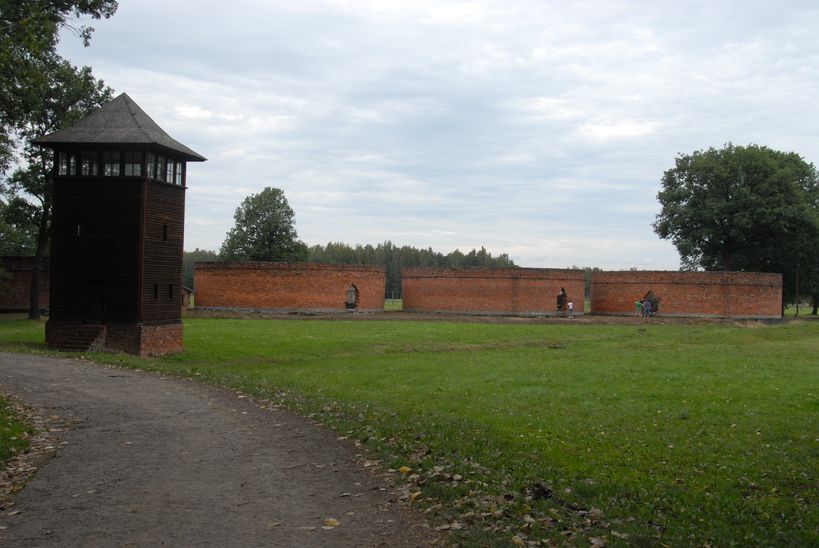
Just behind the water treatment facility were the sorting barracks named Kanada. Here the belongings of the murdered victims were sorted and checked for hidden jewelry and money. Besides the foundations of the former wooden barracks, there is nothing left of Kanada, just a few signs show how this part of the camp looked like at the time.
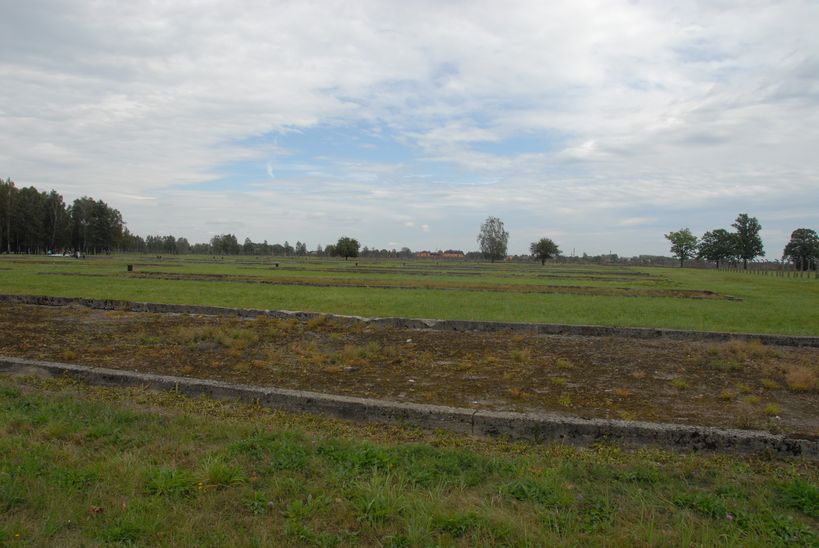
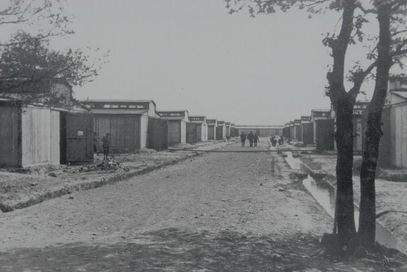
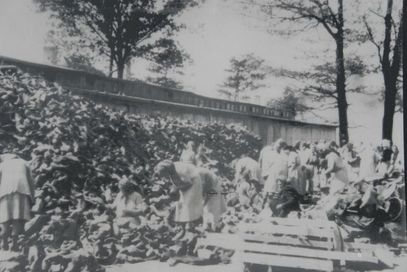
Kanada
Behind Kanada were the gas chambers IV and V. It is striking that in this corner of the camp, the depicted atmosphere is much harder than in the much busier visited area around the platform. The first part shows virtually no shocking photographs. Here in the rear section however, they placed more shocking photos. The depicted images show people who are waiting for their death and other terrible scenes. Like all the photos in the camp they are exactly located at the location where they were taken at the time.
Krema IV was destroyed by the Jewish prisoners of the Sonderkommando on October 7, 1944. They started a fire in the gas chamber to bring the killings to an end. Their goal was reached for this gas chamber, the gas chamber was completely destroyed and couldn’t be used again after. The members of the Sonderkommando were murdered by the Germans after.
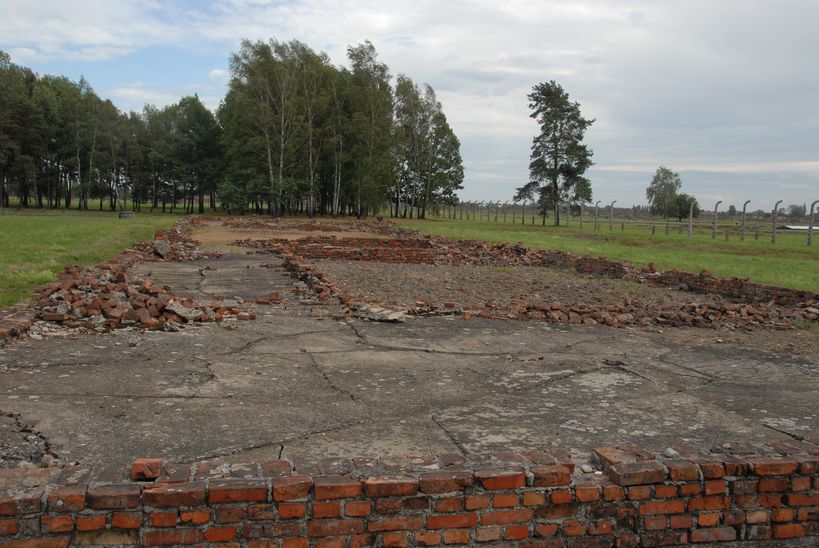
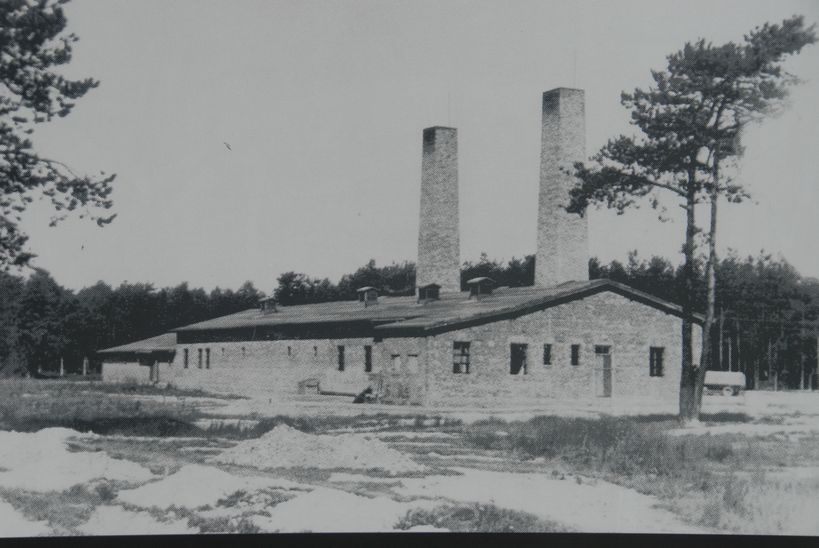
Krema IV
Behind Krema IV is a large former ash pit. At first it seems like a peaceful pond, but a sign and a monument point to the history of this pond. The ashes of thousands of people were plunged into that pit. In and around the camp, many of these pits were found.
The place with the trees beside the pit was a location where people had to wait for their certain death before they were gassed. A sign with two pictures that were taken on this location indicates this gruesome scene. Because the gas chambers were full, the victims were waiting between the trees, what must these people have thought, unbelievable….
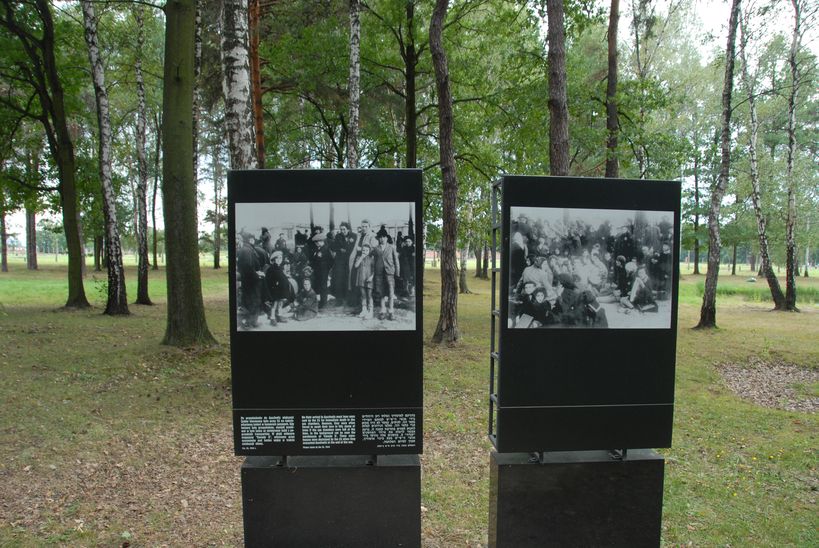
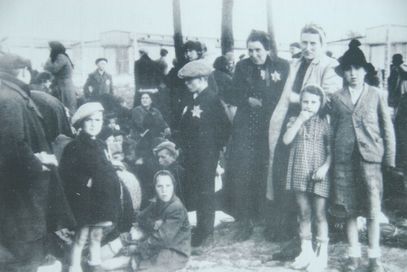
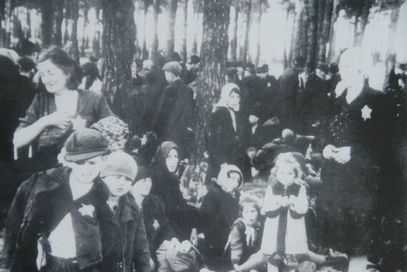
The waiting victims, the trees around the pit and the sorting barracks of Kanada in the background are clearly visible.
The remains of the building Krema V are still very clearly visible, with details like the cement floor with drains and metal frames of the furnaces. The sign with pictures of an open air incinerationof bodies right behind Krema V, impresses. It's definitely worth to visit this remote part of the camp, this section is much more impressive, also due to the silence in this part of the camp.
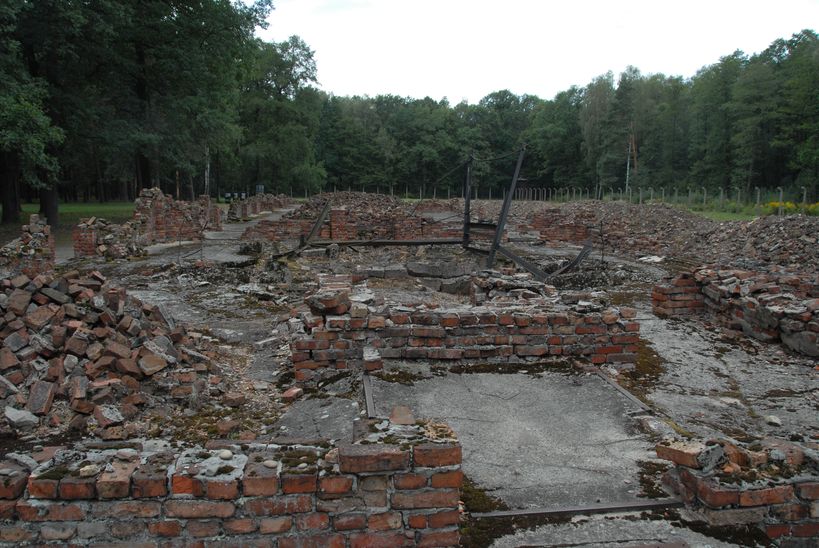
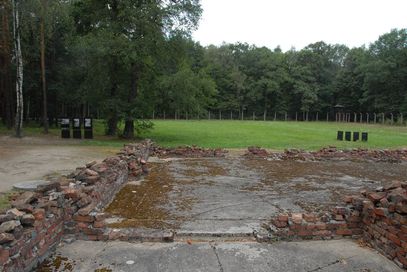
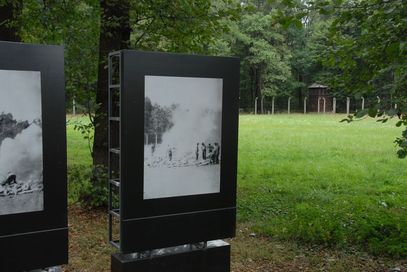
Krema V
From this far corner of the camp, it is quite a walk to the entrance of the camp. Way you pass through several information boards that give a picture of the layout of the camp. After a 2 km walk, some barracks can be viewed. These wooden barracks show how the prisoners slept.
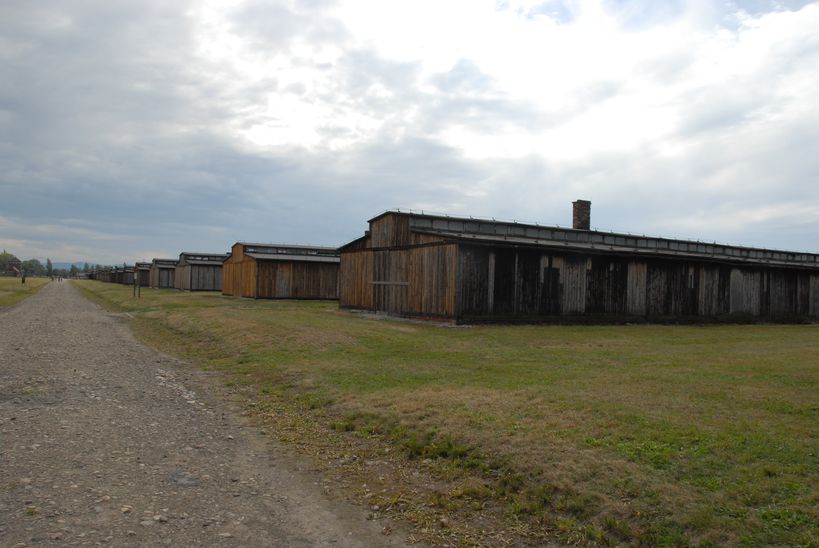
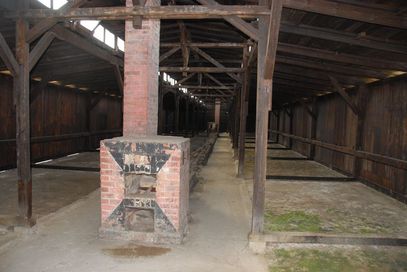
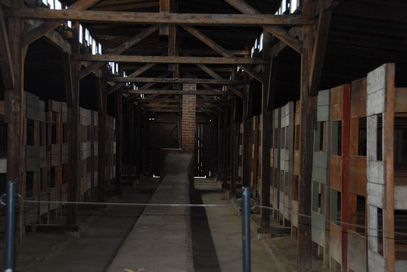
The hitherto visited locations are all located on the right side of the platform. To the left of the platform you can also visit a number of barracks.
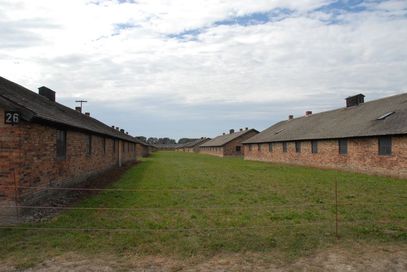
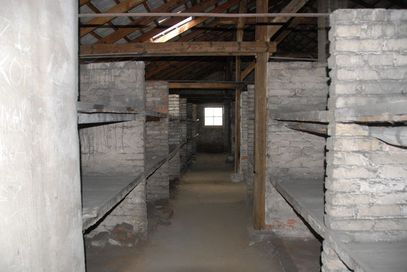
You can find the remnants of a barracks where the child victims of Joseph Mengele slept. These children, mostly twins were used by Mengele for medical experiments.
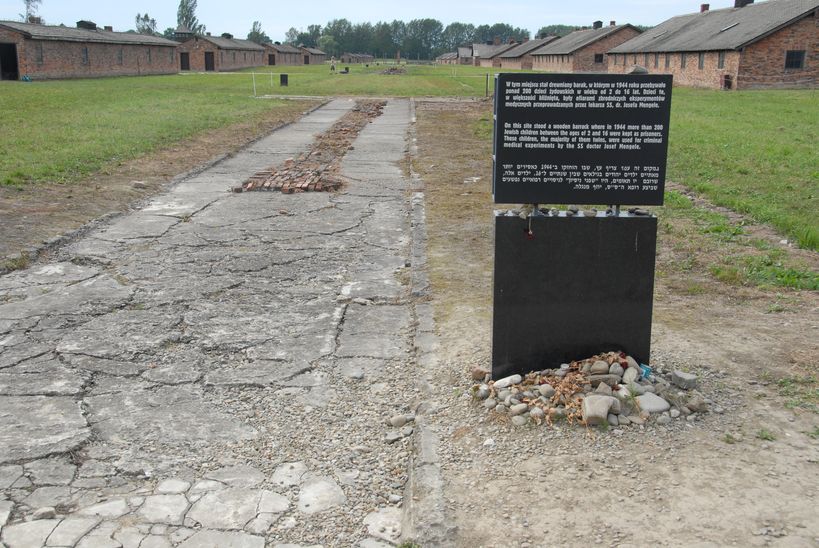
Two barracks were used as sanitary buildings.
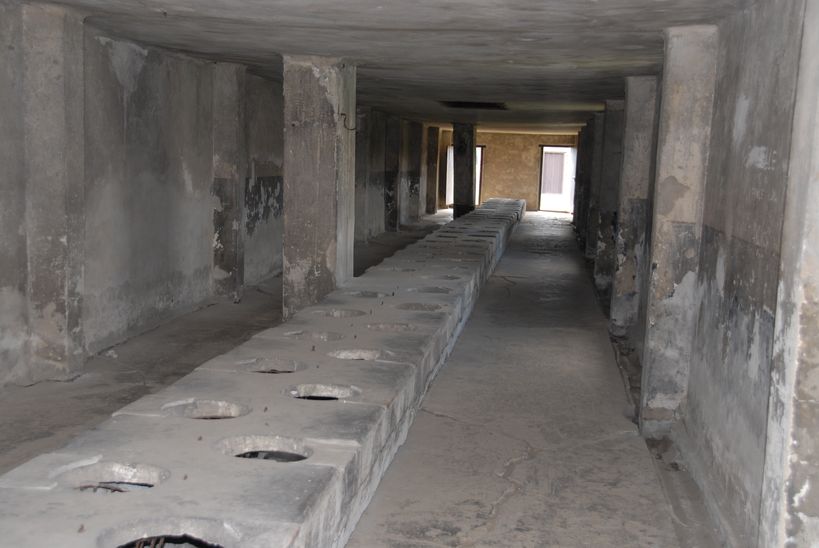
Toilets
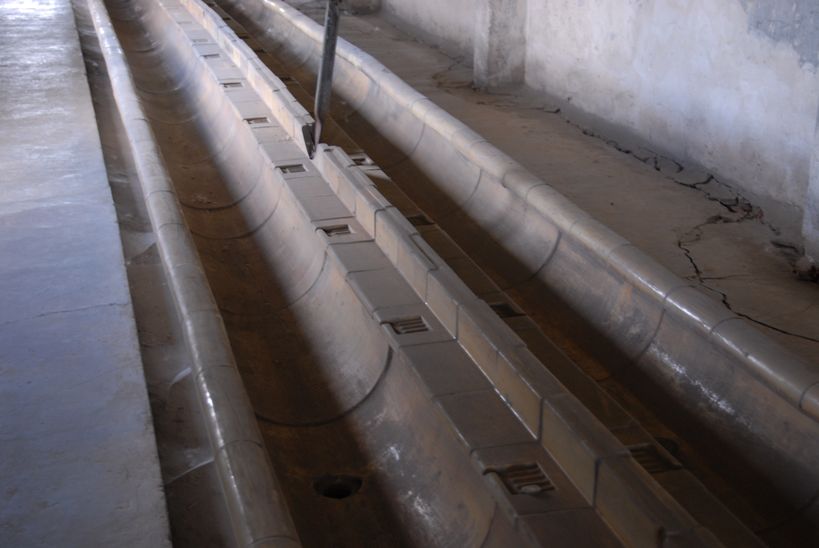
Washroom
Around Auschwitz-Birkenau are several monuments and sites to visit. For example, there are several ash pits and the locations of the first gas chambers can be found, Bunker I and II. Bunker I (the little red house) was a farm that was converted into a gas chamber. There is nothing left of this gas chamber but an empty field with a monument remembers the location.
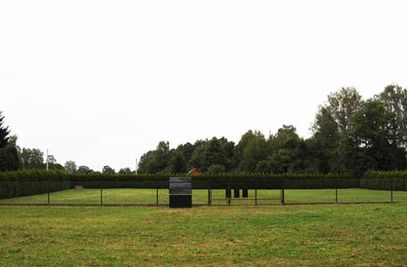
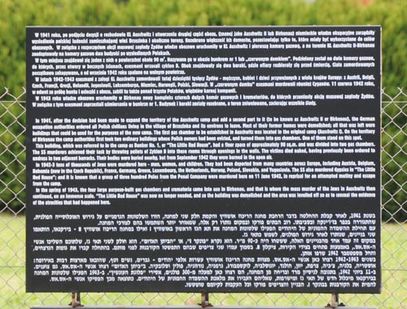
Bunker I location
The location of Bunker II (the small white house) can also be visited. There is a monument commemorating the victims who perished here. Bunker II can be visited from the camp through a long walkway.
Auschwitz I
On arrival in Oœwiêcim you can choose to visit Auschwitz I or Auschwitz II (Birkenau) first. Auschwitz I is the smaller camp with the stone barracks. The former Polish army base was converted by the Germans into a concentration camp. The camp is best known for the famous Arbeit Macht Frei gate, which oddly enough is not the first view of the camp, after the passing of some buildings you'll arrive at the gate.

Several buildings are used as exhibition rooms. The first row of barracks are used for exhibits about the war in Poland and other general information about the war. The second row of barracks, including the infamous Block 11, mainly display information and materials about the two camps.



A very strange fact is that some barracks and the former home of Rudolf Höss are in use as houses. These houses overlook the gas chamber of the camp and the gallows where Rudolf Höss was hanged after the war. They are part of the camp but are separated by a steel gate.
Inside this gas chamber, thousands of people were killed. The gas chamber consists of several areas, including the gas chamber itself and a crematorium. In the crematorium is a turntable rails that is mounted on the ground. These were clearly to optimize and accelerate the killing process.



The most infamous building at the camp is undoubtedly Block 11 The building where the first gassings with Zyklon B took place. In the underground section where the gassings of Russian prisoners have occurred, are many cells that can be visited. Some of these cells are starve cells and standing cells .The atmosphere inside the barracks is sinister, the worn stairs to the basement was the last steps for many.


Next to Block 11, was an execution site.

In the barracks next to Block 11, the camp life in Auschwitz is reviewed. The entrance hallways are filled with photos of prisoners who were murdered in Auschwitz.

One barrack is filled with the properties of former prisoners. There are huge amounts of glasses, bags, shoes and many other items displayed.



The gallows where the camp commandant Rudolf Höss was hanged stands about 100 yards behind his former home, right behind the gas chamber where many thousands were killed.

Auschwitz II
Auschwitz II (Birkenau) is a much larger camp which was built in a later stadium. This camp is clearly much more focused on murder than the first camp, had four gas chambers instead of one and the setup was much simpler and inhuman. On the road from Auschwitz I to II, it is worth to visit the Judenrampe. This former train platform was put into use as a memorial to the hundreds of thousands of people who arrived here after their long train journey. A cattle wagon, same type as was then used to transport the mostly Jewish victims, is a silent witness to what happened here.


In short distance from the Judenrampe, you will find the spacious new parking lot for Auschwitz II. The well-known entrance of Birkenau, which in films appears to immense, is in practice a lot smaller. That’s not what you can say about the immense camp which lies behind this gate. The camp is so large that most people only walk along the platform up to the monument and former gas chambers II and III. Only a few walk along the entire camp, which has about a radius of 5 kilometers. The paths around the camp are not that good everywhere, diverse paths consist of large coarse pebbles which makes walking difficult. With a wheelchair it will be impossible.

The route to the monument, which is also the route to the big gas chambers Krema II and Krema III is basically one big train platform. Halfway through the platform stands a cattle wagon and some boards with photographs showing how it looked like here in 1944. Many of the persons represented were killed shortly after arriving in one of the chambers that were in the camp. Of the gas chambers is not much left, they were blown up at the end of the war by the Germans, signs with photos and a layout make clear how they looked.



Krema II



Krema III
To the right of these two chambers you can continue walking towards the gas chambers IV and V.

Just behind the water treatment facility were the sorting barracks named Kanada. Here the belongings of the murdered victims were sorted and checked for hidden jewelry and money. Besides the foundations of the former wooden barracks, there is nothing left of Kanada, just a few signs show how this part of the camp looked like at the time.



Kanada
Behind Kanada were the gas chambers IV and V. It is striking that in this corner of the camp, the depicted atmosphere is much harder than in the much busier visited area around the platform. The first part shows virtually no shocking photographs. Here in the rear section however, they placed more shocking photos. The depicted images show people who are waiting for their death and other terrible scenes. Like all the photos in the camp they are exactly located at the location where they were taken at the time.
Krema IV was destroyed by the Jewish prisoners of the Sonderkommando on October 7, 1944. They started a fire in the gas chamber to bring the killings to an end. Their goal was reached for this gas chamber, the gas chamber was completely destroyed and couldn’t be used again after. The members of the Sonderkommando were murdered by the Germans after.


Krema IV
Behind Krema IV is a large former ash pit. At first it seems like a peaceful pond, but a sign and a monument point to the history of this pond. The ashes of thousands of people were plunged into that pit. In and around the camp, many of these pits were found.
The place with the trees beside the pit was a location where people had to wait for their certain death before they were gassed. A sign with two pictures that were taken on this location indicates this gruesome scene. Because the gas chambers were full, the victims were waiting between the trees, what must these people have thought, unbelievable….



The waiting victims, the trees around the pit and the sorting barracks of Kanada in the background are clearly visible.
The remains of the building Krema V are still very clearly visible, with details like the cement floor with drains and metal frames of the furnaces. The sign with pictures of an open air incinerationof bodies right behind Krema V, impresses. It's definitely worth to visit this remote part of the camp, this section is much more impressive, also due to the silence in this part of the camp.



Krema V
From this far corner of the camp, it is quite a walk to the entrance of the camp. Way you pass through several information boards that give a picture of the layout of the camp. After a 2 km walk, some barracks can be viewed. These wooden barracks show how the prisoners slept.



The hitherto visited locations are all located on the right side of the platform. To the left of the platform you can also visit a number of barracks.


You can find the remnants of a barracks where the child victims of Joseph Mengele slept. These children, mostly twins were used by Mengele for medical experiments.

Two barracks were used as sanitary buildings.

Toilets

Washroom
Around Auschwitz-Birkenau are several monuments and sites to visit. For example, there are several ash pits and the locations of the first gas chambers can be found, Bunker I and II. Bunker I (the little red house) was a farm that was converted into a gas chamber. There is nothing left of this gas chamber but an empty field with a monument remembers the location.


Bunker I location
The location of Bunker II (the small white house) can also be visited. There is a monument commemorating the victims who perished here. Bunker II can be visited from the camp through a long walkway.
Used source(s)
- Source: Paul & Anneke Moerenhout, STIWOT
- Published on: 01-01-2017 13:32:05
Latest news
- 03-10: Photo report other Airborne commemorations and events 2025
- 01-10: Photo report commemoration Wiltshire memorial
- 30-09: Photo report other Airborne commemorations and events 2025
- 26-09: Photo report Ounveiling Plaque 'Gunners within 1st Airborne Division'
- 25-09: Photo report unveiling Plaque 'Gunners within 1st Airborne Division'
- 24-09: Photo report Airborne commemoration Driel
- 23-09: Photo report Airborne Landing and Commemoration
- 22-09: Photo report Airborne Memorial Service Oosterbeek
- 23-06: Keeping the memory of the trails to freedom alive
- 12-04: Understanding the German side of the fighting in Normandy

